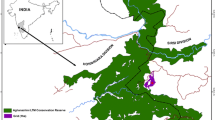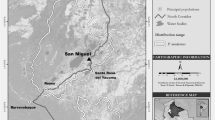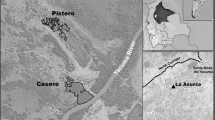Abstract
Seasonal fluctuation in food availability is a universal problem for wild animals. One common response to dietary changes is to modify ranging patterns. We studied the ranging pattern of one group (8–12 individuals) of red leaf monkeys (Presbytis rubicunda) in the lowland dipterocarp forest of Danum Valley, Borneo from December 2006 to December 2008. The seasonal availability of fruits varies significantly in this forest because of mast fruiting. We tested the hypothesis that changes in ranging pattern are linked with seasonal changes in diet in this species. We recorded activity, foods eaten, and location every 10 min from around 06:00 until 16:00 h, 5–10 days/mo. The home range size was 21.4 ha over the 25-mo study (95% kernel contour). There were no statistically significant relationships between feeding times on the four major nonexclusive dietary components (all species of seeds, all species of young leaves, young leaves of Spatholobus macropterus, and other species of young leaves) and either the home range (95% kernel contour) or the core area (50% kernel contour). The areas used in the seed-eating and non-seed-eating seasons overlapped to a large extent. The daily path length was 1160 ± 340 m (mean ± SD, range: 550–2140 m). Neither daily path length nor monthly mean travel rate was significantly related to feeding time on any of the four major dietary components. The group’s ranging patterns may be related to the unusual fallback strategy of this population, which depends on the young leaves of an abundant liana (S. macropterus), which are available in small patches. The monkeys need only a small home range because of the high abundance of these leaves. However, they range a relatively long distance because the patches of S. macropterus are easily depleted; thus the ranging distance does not decrease in non-seed-eating periods.

Similar content being viewed by others
References
Agetsuma, N. (1995). Foraging strategies of Yakushima macaques (Macaca fuscata yakui). International Journal of Primatology, 16(4), 595–609.
Agostini, I., Holzmann, I., & Di Bitetti, M. S. (2010). Ranging patterns of two syntopic howler monkey species (Alouatta guariba and A. caraya) in northeastern Argentina. International Journal of Primatology, 31(3), 363–381.
Bennett, E. L. (1986). Environmental correlates of ranging behavior in the banded langur, Presbytis melalophos. Folia Primatologica, 47(1), 26–38.
Bennett, E. L., & Sebastian, A. C. (1988). Social organization and ecology of proboscis monkeys (Nasalis larvatus) in mixed coastal forest in Sarawak. International Journal of Primatology, 9(3), 233–255.
Bleisch, W., Song, C. A., Ren, X. D., & Xie, J. H. (1993). Preliminary results from a field study of wild Guizhou snub-nosed monkeys (Rhinopithecus brelichi). Folia Primatologica, 60(1–2), 72–82.
Buij, R., Wich, S. A., Lubis, A. H., & Sterck, E. H. M. (2002). Seasonal movements in the Sumatran orangutan (Pongo pygmaeus abelii) and consequences for conservation. Biological Conservation, 107(1), 83–87.
Campera, M., Serra, V., Balestri, M., Barresi, M., Ravaolahy, M., Randriatafika, F., & Donati, G. (2014). Effects of habitat quality and seasonality on ranging patterns of collared brown lemur (Eulemur collaris) in littoral forest fragments. International Journal of Primatology, 35(5), 957–975.
Clarke, K. R. (1993). Nonparametric multivariate analyses of changes in community structure. Australian Journal of Ecology, 18(1), 117–143.
Davies, G. (1991). Seed-eating by red leaf monkeys (Presbytis rubicunda) in dipterocarp forest of northern Borneo. International Journal of Primatology, 12(2), 119–144.
Ehlers Smith, D. A., Ehlers Smith, Y. C., & Cheyne, S. M. (2013). Home-range use and activity patterns of the red langur (Presbytis rubicunda) in Sabangau tropical peat-swamp forest, central Kalimantan, Indonesian Borneo. International Journal of Primatology, 34(5), 957–972.
Fan, P. F., Garber, P., Chi, M., Ren, G. P., Liu, C. M., Chen, X. Y., & Yang, J. X. (2015). High dietary diversity supports large group size in Indo-Chinese gray langurs in Wuliangshan, Yunnan, China. American Journal of Primatology, 77(5), 479–491.
Fashing, P. J. (2001a). Activity and ranging patterns of guerezas in the Kakamega Forest: intergroup variation and implications for intragroup feeding competition. International Journal of Primatology, 22(4), 549–577.
Fashing, P. J. (2001b). Feeding ecology of guerezas in the Kakamega Forest, Kenya: the importance of Moraceae fruit in their diet. International Journal of Primatology, 22(4), 579–609.
Fashing, P. J., Dierenfeld, E. S., & Mowry, C. B. (2007). Influence of plant and soil chemistry on food selection, ranging patterns, and biomass of Colobus guereza in Kakamega Forest, Kenya. International Journal of Primatology, 28(3), 673–703.
Fleury, M. C., & Gautier-Hion, A. (1999). Seminomadic ranging in a population of black colobus (Colobus satanas) in Gabon and its ecological correlates. International Journal of Primatology, 20(4), 491–509.
Fuentes, A. (1996). Feeding and ranging in the Mentawai island langur (Presbytis potenziani). International Journal of Primatology, 17(4), 525–548.
Grueter, C. C., Li, D. Y., van Schaik, C. P., Ren, B. P., Long, Y. C., & Wei, F. W. (2008). Ranging of Rhinopithecus bieti in the Samage Forest, China. I. Characteristics of range use. International Journal of Primatology, 29(5), 1121–1145.
Hanya, G. (2004). Diet of a Japanese macaque troop in the coniferous forest of Yakushima. International Journal of Primatology, 25(1), 55–71.
Hanya, G., & Bernard, H. (2012). Fallback foods of red leaf monkeys (Presbytis rubicunda) in Danum Valley, Borneo. International Journal of Primatology, 33(2), 322–337.
Hanya, G., & Bernard, H. (2013). Functional response to fruiting seasonality by a primate seed predator, red leaf monkey (Presbytis rubicunda). Tropical Ecology, 54(3), 383–395.
Hanya, G., & Bernard, H. (2015). Different roles of seeds and young leaves in the diet of red leaf monkeys (Presbytis rubicunda): comparisons of availability, nutritional properties, and associated feeding behavior. International Journal of Primatology, 36(1), 177–193.
Hanya, G., & Chapman, C. A. (2013). Linking feeding ecology and population abundance: a review of food resource limitation on primates. Ecological Research, 28(2), 183–190.
Hanya, G., Yoshihiro, S., Zamma, K., Matsubara, H., Ohtake, M., Kubo, R., Noma, N., Agetsuma, N., & Takahata, Y. (2004). Environmental determinants of the altitudinal variations in relative group densities of Japanese macaques on Yakushima. Ecological Research, 19(5), 485–493.
Hanya, G., Kiyono, M., Yamada, A., Suzuki, K., Furukawa, M., Yoshida, Y., & Chijiiwa, A. (2006). Not only annual food abundance but also fallback food quality determines the Japanese macaque density: evidence from seasonal variations in home range size. Primates, 47(3), 275–278.
Hanya, G., Tsuji, Y., & Grueter, C. C. (2013). Fruiting and flushing phenology in Asian tropical and temperate forests: implications for primate ecology. Primates, 54(2), 101–110.
Harris, T. R., & Chapman, C. A. (2007). Variation in diet and ranging of black and white colobus monkeys in Kibale National Park, Uganda. Primates, 48(3), 208–221.
Hemingway, C., & Bynum, N. (2005). The influence of seasonality on primate diet and ranging. In D. K. Brockman & C. P. van Schaik (Eds.), Seasonality in primates: Studies of living and extinct human and non-human primates (pp. 57–104). Cambridge: Cambridge University Press.
Hill, D. A., & Agetsuma, N. (1995). Supra-annual variation in the influence of Myrica rubra fruit on the behavior of a troop of Japanese macaques in Yakushima. American Journal of Primatology, 35(3), 241–250.
Islam, M. A., & Husain, K. Z. (1982). A preliminary study on the ecology of the capped langur. Folia Primatologica, 39(1–2), 145–159.
Ito, T. Y., & Takatsuki, S. (2005). Relationship between a high density of sika deer and productivity of the short-grass (Zoysia japonica) community: a case study on Kinkazan Island, northern Japan. Ecological Research, 20(5), 573–579.
Jose-Dominguez, J. M., Savini, T., & Asensio, N. (2015). Ranging and site fidelity in northern pigtailed macaques (Macaca leonina) over different temporal scales. American Journal of Primatology, 77(8), 841–853.
Kanamori, T., Kuze, N., Bernard, H., Malim, T. P., & Kohshima, S. (2010). Feeding ecology of Bornean orangutans (Pongo pygmaeus morio) in Danum Valley, Sabah, Malaysia: a 3-year record including two mast fruitings. American Journal of Primatology, 72(9), 820–840.
Kirkpatrick, R. C., Long, Y. C., Zhong, T., & Xiao, L. (1998). Social organization and range use in the Yunnan snub-nosed monkey Rhinopithecus bieti. International Journal of Primatology, 19(1), 13–51.
Kool, K. M. (1993). The diet and feeding behavior of the silver leaf monkey (Trachypithecus auratus sondaicus) in Indonesia. International Journal of Primatology, 14(5), 667–700.
Krebs, C. J. (1999). Ecological methodology. San Francisco: Benjamin/Cummings.
Kurihara, Y., & Hanya, G. (2015). Comparison of feeding behavior between two different-sized groups of Japanese macaques (Macaca fuscata yakui). American Journal of Primatology, 77(9), 986–1000.
Lambert, J. E. (1998). Primate digestion: interactions among anatomy, physiology, and feeding ecology. Evolutionary Anthropology, 7(1), 8–20.
Li, Z. Y., & Rogers, M. E. (2005). Habitat quality and range use of white-headed langurs in Fusui, China. Folia Primatologica, 76(4), 185–195.
Matsuda, I., Tuuga, A., & Higashi, S. (2009). Ranging behavior of proboscis monkeys in a riverine forest with special reference to ranging in inland forest. International Journal of Primatology, 30(2), 313–325.
McKey, D. B., Gartlan, J. S., Waterman, P. G., & Choo, G. M. (1981). Food selection by black colobus monkeys (Colobus satanas) in relation to plant chemistry. Biological Journal of the Linnean Society, 16(2), 115–146.
Milton, K. (1981). Distribution patterns of tropical plant foods as an evolutionary stimulus to primate mental-development. American Anthropologist, 83(3), 534–548.
Mitani, J. C., & Rodman, P. S. (1979). Territoriality: relation of ranging pattern and home range size to defendability, with an analysis of territoriality among primate species. Behavioral Ecology and Sociobiology, 5(3), 241–251.
Mukherjee, R. P., & Saha, S. S. (1974). The golden langurs (Presbytis geei Khajuria, 1956) of Assam. Primates, 15(4), 327–340.
Nakagawa, N., Iwamoto, T., Yokota, N., & Soumah, A. G. (1996). Inter-regional and inter-seasonal variations of food quality in Japanese macaques: Constraints of digestive volume and feeding time. In J. E. Fa & D. G. Lindburg (Eds.), Evolution and ecology of macaque societies (pp. 207–234). New York: Cambridge University Press.
Newton, P. (1992). Feeding and ranging patterns of forest hanuman langurs (Presbytis entellus). International Journal of Primatology, 13(3), 245–285.
O’Brien, T. G., & Kinnaird, M. F. (1997). Behavior, diet, and movements of the Sulawesi crested black macaque (Macaca nigra). International Journal of Primatology, 18(3), 321–351.
Oates, J. F. (1977). The guereza and its food. In T. H. Clutton-Brock (Ed.), Primate ecology: Studies of feeding and ranging behaviour in lemurs, monkeys and apes (pp. 275–321). London: Academic Press.
Oates, J. F., Waterman, P. G., & Choo, G. M. (1980). Food selection by the south Indian leaf monkey, Presbytis johnii, in relation to leaf chemistry. Oecologia, 45(1), 45–56.
Ruhiyat, Y. (1983). Socio-ecological study of Presbytis aygula in West Java. Primates, 24(3), 344–359.
Sakai, S. (2002). General flowering in lowland mixed dipterocarp forests of South-east Asia. Biological Journal of the Linnean Society, 75(2), 233–247.
Sayers, K., & Norconk, M. A. (2008). Himalayan Semnopithecus entellus at Langtang National Park, Nepal: diet, activity patterns, and resources. International Journal of Primatology, 29(2), 509–530.
Schuler, K. L., Schroeder, G. M., Jenks, J. A., & Kie, J. G. (2014). Ad hoc smoothing parameter performance in kernel estimates of GPS-derived home ranges. Wildlife Biology, 20(5), 259–266.
Stanford, C. B. (1991). The diet of the capped langur (Presbytis pileata) in a moist deciduous forest in Bangladesh. International Journal of Primatology, 12(3), 199–216.
Supriatna, J., Manullang, B. O., & Soekara, E. (1986). Group composition, home range, and diet of the maroon leaf monkey (Presbytis rubicunda) at Tanjung Puting Reserve, Central Kalimantan, Indonesia. Primates, 27(2), 185–190.
Tsuji, Y., Hanya, G., & Grueter, C. C. (2013). Feeding strategies of primates in temperate and alpine forests: comparison of Asian macaques and colobines. Primates, 54(3), 201–215.
van Schaik, C. P., Terborgh, J. W., & Wright, S. J. (1993). The phenology of tropical forests: adaptive significance and consequences for primary consumers. Annual Review of Ecology and Systematics, 24, 353–377.
Volampeno, M. S. N., Masters, J. C., & Downs, C. T. (2011). Home range size in the blue-eyed black lemur (Eulemur flavifrons): a comparison between dry and wet seasons. Mammalian Biology, 76(2), 157–164.
Wich, S. A., & van Schaik, C. P. (2000). The impact of El Niño on mast fruiting in Sumatra and elsewhere in Malesia. Journal of Tropical Ecology, 16, 563–577.
Wong, S. T., Servheen, C., Ambu, L., & Norhayati, A. (2005). Impacts of fruit production cycles on Malayan sun bears and bearded pigs in lowland tropical forest of Sabah, Malaysian Borneo. Journal of Tropical Ecology, 21, 627–639.
Wrangham, R. W., Gittleman, J. L., & Chapman, C. A. (1993). Constraints on group size in primates and carnivores: population density and day range as assays of exploitation competition. Behavioral Ecology and Sociobiology, 32(3), 199–209.
Zhang, D., Fei, H. L., Yuan, S. D., Sun, W. M., Ni, Q. Y., Cui, L. W., & Fan, P. F. (2014). Ranging behavior of eastern hoolock gibbon (Hoolock leuconedys) in a northern montane forest in Gaoligongshan, Yunnan, China. Primates, 55(2), 239–247.
Zhou, Q. H., Huang, C. M., Li, Y. B., & Cai, X. W. (2007). Ranging behavior of the francois’ langur (Trachypithecus francoisi) in the Fusui Nature Reserve, China. Primates, 48(4), 320–323.
Acknowledgments
This study would not have been possible without the hard work of our field assistants, Syamsudin Jail, Sharry bin Mustah, Saharudin Idos, Unding Jami, Sallehudin Jail, and Rayner Jupili. We are greatly indebted to the staff of the Danum Valley Field Centre and our colleagues there for their hospitality and help, in particular Jimmy Omar, Mike Bernadus, Glen Reynolds, Tomoko Kanamori, Noko Kuze, and Siew Te Wong. The Economy Planning Unit of Malaysia, the State of Sabah, and the Danum Valley Management Committee of Yayasan Sabah permitted our study. Drs. Jo Setchell, Jessica Rothman, Andrew J. J. MacIntosh, and two anonymous reviewers offered us helpful comments. This study was financed by the Japan Society for the Promotion of Science (JSPS) Core-to-Core Program (HOPE); Japan’s Ministry of Education, Culture, Sports, Science and Technology (MEXT) Grant-in-Aid for JSPS Overseas Fellows, Grant-in-Aid for Young Scientists B (No. 20770195) and A (No. 22687002) and Scientific Research B (No. 25291100) to G. Hanya; Primate Society of Japan; and the Global Centers of Excellence (COE) Program “Formation of a Strategic Base for Biodiversity and Evolutionary Research: From Genome to Ecosystem.”
Author information
Authors and Affiliations
Corresponding author
Electronic supplementary material
Below is the link to the electronic supplementary material.
ESM 1
(DOC 313 kb)
Rights and permissions
About this article
Cite this article
Hanya, G., Bernard, H. Seasonally Consistent Small Home Range and Long Ranging Distance in Presbytis rubicunda in Danum Valley, Borneo. Int J Primatol 37, 390–404 (2016). https://doi.org/10.1007/s10764-016-9907-z
Received:
Accepted:
Published:
Issue Date:
DOI: https://doi.org/10.1007/s10764-016-9907-z




